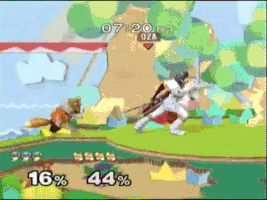Note: This article was originally posted elsewhere, but I adapted it for the Bunker because I thought that y’all might find it interesting.
Hey all! Happy Halloween. I’m back with another article, and like last time, I’m going to apply the concept of mechanics as metaphor – where game mechanics convey character and personality – to a moveset within Smash, and see how it’s used. While this article isn’t particularly spooky, it does cover something that all Smash fans dread: clone characters.

The legendary trio.
Smash will often add to its roster existing all-stars, but it might also make some lesser-known characters famous due to their appearances in the mascot fighter. Captain Falcon and Ness are good examples of this, but our focus today is on another of these Smash all-stars: the Hero King himself, Marth!
Originally known only to Japanese audiences, Marth found his way over to the West through Melee, where his popularity as a fighter led to Fire Emblem being localized for worldwide audiences and eventually becoming a smash hit with Awakening. Marth also brought with him a clone, Roy, and these two fighters both return in Smash 4 along with newcomer Lucina. All three of these characters share a similar moveset (even if Roy saw significant changes in the latest game), so today we’ll be covering all three and seeing how even slight tweaks in move attributes can convey different character traits. Also, there will be some spoilers for Fire Emblem games, so be warned.
Marth was originally going to be included in Smash 64, but had to be scrapped due to time constraints. Marth was intended to fill the role of a sword wielder, but in a different way from Link. In an interview translated by Source Gaming, Sakurai said, “I thought in comparison to Link—who’s more of a strong, direct swordsman—someone with finesse, a swordsman who relied more on technique, would be a lot of fun.”
This definitely shows in Marth’s moveset, with precise sweetspots and elegant combos and swings. Melee’s version of the Hero King is perhaps the best example, as his swings flow into each other more smoothly than a knife cutting through butter, including the famous Ken Combo. Marth is the definition of elegance, precision, and finesse. His confidence from the Fire Emblem series shows here too, as a skilled Marth player can be certain that these hits will connect. Due to the consistency of Marth’s attacks, such as the consistent position of his tipper hitbox or the low-scaling knockback of his weak hitboxes, his combos will always work, and the player can be confident in this. By playing as Marth, you become confident in your abilities, and your play becomes elegant, precise, and beautiful.

Like this!
While Marth’s inclusion in Smash brought about Fire Emblem’s popularity overseas, Lucina was added to the game as a result of this popularity. This is quite fitting, seeing as how Lucina is a descendant of Marth! This also means that her moveset is cloned from that of the Hero King, although there are subtle differences. Lucina’s blade lacks the precise sweetspots of Marth’s, dealing more damage than his weak hitboxes but not being as strong as his tipper. As such, Lucina is less demanding than Marth is, and it is possible to be more reckless and perform up-close strikes without dealing pitiful damage.
In Fire Emblem: Awakening, Lucina reflects some of these attributes, if not in her personality. She poses as Marth for a decent chunk of Awakening’s story, but accidentally reveals her true identity. She tries to imitate Marth, but is not quite the same. This is similar to how in Smash, her moveset is almost the same as Marth’s, but not quite identical. Additionally, in Awakening, her Parallel Falchion has its full power unlocked from the start. Meanwhile, Chrom’s version of the Falchion is weaker at first, its true power sealed away, but this potential can eventually be unlocked to make his blade stronger than Lucina’s. This mirrors how in Smash, Lucina is more effective than Marth is when you lack experience with the characters, but Marth can be devastating if used to his full potential.
Lucina’s personality in Smash is also noteworthy. Her character is not particularly reckless in Awakening, instead being somewhat pessimistic or depressed due to the death of her family. In Smash, however, Sakurai used some creative license and gave Lucina a more energetic flair, with her voice clips from her taunts and her Final Smash reflecting this. She still shows Marth’s confidence, and even surpasses it (“Come at me!”), but with an added element of energy and aggression. Additionally, her Shield Breaker animation is different in that it shows less precision, perhaps a bit of clumsiness of a sort.
In terms of gameplay, Lucina shares Marth’s consistent combos, but there is also more room for aggressive, close-quarters play, or even making mistakes. Even if Lucina’s moveset does not necessarily reflect her personality from Awakening, it definitely delivers a certain aesthetic that goes along perfectly with her voice clips and animations in Smash.
Lucina’s personality was largely invented just for Smash, but a more famous example of this is Roy. As his debut game was not released until Melee’s development was wrapped up and then some, Sakurai had to take cues from descriptions of the character instead of his ingame appearance, leading to some discrepancies. From that same interview:
Sakurai: When I first heard a description of Roy’s character, I felt he was a bit more energetic, had a bit more strength inside of him. So, in comparison to Marth, whose sword is stronger at the tip, I made Roy’s sword stronger near the hilt, which I felt made them feel very different. But I played Binding Blade, and he’s really not like that at all!
In Smash, from his voice clips to his explosive fire attacks and even his reverse grip on his sword, Roy is portrayed as a fighter who is aggressive and filled with energy. He has a passion to him, shared with no other Fire Emblem representative, and his strength conveys that aggression and power. Unlike fellow powerhouse Ike, however, Roy is also quick on his feet, and his power is only at the hilt of his sword. This means that Roy benefits from getting in his opponent’s face, and has the tools to do so.
Roy is clearly meant to make the player feel aggressive, with bursts of mobility and lightning-fast approaches. However, if you pick up Roy and try to use his speed to approach, you may find yourself being punished for approaching with an aerial, such as his nair. Why does Roy’s design encourage aggression, if aggression leads the player to be punished?
Aggression, as a general concept, leads to strength and adrenaline rushes, but it also leads to imprecision and recklessness. By letting out this aggression at the wrong time, your actions will be imprecise, and you will be less capable of thinking things through, leading to mistakes and missteps. Thus, in general, it is crucial to manage this feeling, and keep a level head. Roy is built around this struggle. I think that maybe, Sakurai saw Roy not just as an aggressive character, but one who struggles to control this anger and stay cool.
By playing as Roy, you put yourself in Roy’s shoes. Your first instinct is to run in and approach with an attack such as nair, as it has a lot of combo potential and can be combined with a fast dash in. However, uncontrolled, cocky aggression such as this will only lead to a punish. The key to mastering Roy is keeping this aggression in check.
You must be patient, avoid getting too cocky, resist the urge to run in blindly with an attack. Instead, space around your opponent’s options, be wise, and look for an opening. Once you find that opening, whether it be a whiffed attack or a poorly-considered defensive option, this is when you can unleash that aggression and use it to its full potential. By keeping in the opponent’s face with lightning-fast mobility and strong attacks, Roy can overwhelm his opponent and combo them hard. And with smash attacks as powerful as his, he can use one of his numerous tech-chase setups to read a panicked reaction and deliver a fatal punish. But remember, striking without an opening is punishable and unwise.
Roy is all about aggression – not blind, but controlled. He is most effective when he keeps a level head in neutral, and unleashes his power and rage at exactly the right time. By playing as Roy, you feel his struggle to control this passion, as the design of the character itself is designed to tempt you to make the wrong decision. If you learn to control this, however, you will find that Roy has the combo game, speed, strength, and potential to take down any opponent. A skilled Roy truly can defeat any Fox.

…Well, maybe not in Melee.
Marth, Lucina, and Roy all share the same basic moveset, and yet they deliver very different personalities. Marth is precise and confident, Lucina is more energetic and unwieldy, and Roy is aggressive and hotheaded. Despite their movesets being cloned from an already simplistic fighter and their personalities being different from how they were originally, these three each still deliver a very distinct feel and character. Fire Emblem‘s trio of lords are – through Moveset as Metaphor – Bound by Blade, but Separate by Spirit.
Of course, if combos and burst mobility aren’t your thing, there are other ways for the Roy player to let out his anger…

Ha! Take that, faker.






What do you think?